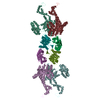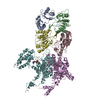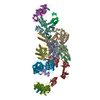[English] 日本語
 Yorodumi
Yorodumi- PDB-1g4b: CRYSTAL STRUCTURES OF THE HSLVU PEPTIDASE-ATPASE COMPLEX REVEAL A... -
+ Open data
Open data
- Basic information
Basic information
| Entry | Database: PDB / ID: 1g4b | ||||||
|---|---|---|---|---|---|---|---|
| Title | CRYSTAL STRUCTURES OF THE HSLVU PEPTIDASE-ATPASE COMPLEX REVEAL AN ATP-DEPENDENT PROTEOLYSIS MECHANISM | ||||||
 Components Components |
| ||||||
 Keywords Keywords | CHAPERONE/HYDROLASE / HSLVU / PEPTIDASE-ATPASE COMPLEX / CHAPERONE-HYDROLASE COMPLEX | ||||||
| Function / homology |  Function and homology information Function and homology informationHslU-HslV peptidase / protein denaturation / HslUV protease complex / proteasome-activating activity / proteasome core complex / protein unfolding / threonine-type endopeptidase activity / proteolysis involved in protein catabolic process / peptidase activity / cellular response to heat ...HslU-HslV peptidase / protein denaturation / HslUV protease complex / proteasome-activating activity / proteasome core complex / protein unfolding / threonine-type endopeptidase activity / proteolysis involved in protein catabolic process / peptidase activity / cellular response to heat / response to heat / protein domain specific binding / magnesium ion binding / ATP hydrolysis activity / proteolysis / ATP binding / identical protein binding / membrane / cytosol / cytoplasm Similarity search - Function | ||||||
| Biological species |  | ||||||
| Method |  X-RAY DIFFRACTION / Resolution: 7 Å X-RAY DIFFRACTION / Resolution: 7 Å | ||||||
 Authors Authors | Wang, J. / Song, J.J. / Franklin, M.C. / Kamtekar, S. / Im, Y.J. / Rho, S.H. / Seong, I.S. / Lee, C.S. / Chung, C.H. / Eom, S.H. | ||||||
 Citation Citation |  Journal: Structure / Year: 2001 Journal: Structure / Year: 2001Title: Crystal structures of the HslVU peptidase-ATPase complex reveal an ATP-dependent proteolysis mechanism. Authors: Wang, J. / Song, J.J. / Franklin, M.C. / Kamtekar, S. / Im, Y.J. / Rho, S.H. / Seong, I.S. / Lee, C.S. / Chung, C.H. / Eom, S.H. #1:  Journal: J.Biol.Chem. / Year: 1996 Journal: J.Biol.Chem. / Year: 1996Title: Purification and Characterization of the Heat Shock Proteins HslV and HslU that form a New ATP-Dependent Protease in Escherichia Coli Authors: Yoo, S.J. / Seol, J.H. / Shin, D.H. / Rohrwild, M. / Kang, M.S. / Tanaka, K. / Goldberg, A.L. / Chung, C.H. #2:  Journal: Nature / Year: 2000 Journal: Nature / Year: 2000Title: The Structuers of HslU and the ATP-Dependent Protease HslU-HslV. Authors: Bochtler, M. / Hartmann, C. / Song, H.K. / Bourenkov, G.P. / Bartunik, H.D. / Huber, R. | ||||||
| History |
|
- Structure visualization
Structure visualization
| Structure viewer | Molecule:  Molmil Molmil Jmol/JSmol Jmol/JSmol |
|---|
- Downloads & links
Downloads & links
- Download
Download
| PDBx/mmCIF format |  1g4b.cif.gz 1g4b.cif.gz | 385.7 KB | Display |  PDBx/mmCIF format PDBx/mmCIF format |
|---|---|---|---|---|
| PDB format |  pdb1g4b.ent.gz pdb1g4b.ent.gz | 305.6 KB | Display |  PDB format PDB format |
| PDBx/mmJSON format |  1g4b.json.gz 1g4b.json.gz | Tree view |  PDBx/mmJSON format PDBx/mmJSON format | |
| Others |  Other downloads Other downloads |
-Validation report
| Summary document |  1g4b_validation.pdf.gz 1g4b_validation.pdf.gz | 508.1 KB | Display |  wwPDB validaton report wwPDB validaton report |
|---|---|---|---|---|
| Full document |  1g4b_full_validation.pdf.gz 1g4b_full_validation.pdf.gz | 729.5 KB | Display | |
| Data in XML |  1g4b_validation.xml.gz 1g4b_validation.xml.gz | 102.6 KB | Display | |
| Data in CIF |  1g4b_validation.cif.gz 1g4b_validation.cif.gz | 134.8 KB | Display | |
| Arichive directory |  https://data.pdbj.org/pub/pdb/validation_reports/g4/1g4b https://data.pdbj.org/pub/pdb/validation_reports/g4/1g4b ftp://data.pdbj.org/pub/pdb/validation_reports/g4/1g4b ftp://data.pdbj.org/pub/pdb/validation_reports/g4/1g4b | HTTPS FTP |
-Related structure data
- Links
Links
- Assembly
Assembly
| Deposited unit | 
| ||||||||
|---|---|---|---|---|---|---|---|---|---|
| 1 | 
| ||||||||
| Unit cell |
|
- Components
Components
| #1: Protein | Mass: 49659.703 Da / Num. of mol.: 4 Source method: isolated from a genetically manipulated source Source: (gene. exp.)   #2: Protein | Mass: 18986.641 Da / Num. of mol.: 4 Source method: isolated from a genetically manipulated source Source: (gene. exp.)   |
|---|
-Experimental details
-Experiment
| Experiment | Method:  X-RAY DIFFRACTION / Number of used crystals: 1 X-RAY DIFFRACTION / Number of used crystals: 1 |
|---|
- Sample preparation
Sample preparation
| Crystal | Density Matthews: 4.02 Å3/Da / Density % sol: 69.39 % | ||||||||||||||||||||||||||||||||||||||||||||||||||||||
|---|---|---|---|---|---|---|---|---|---|---|---|---|---|---|---|---|---|---|---|---|---|---|---|---|---|---|---|---|---|---|---|---|---|---|---|---|---|---|---|---|---|---|---|---|---|---|---|---|---|---|---|---|---|---|---|
| Crystal grow | Method: vapor diffusion / Details: dADP-HslU-HslV, VAPOR DIFFUSION | ||||||||||||||||||||||||||||||||||||||||||||||||||||||
| Crystal grow | *PLUS pH: 7.8 / Method: vapor diffusion, hanging drop | ||||||||||||||||||||||||||||||||||||||||||||||||||||||
| Components of the solutions | *PLUS
|
-Data collection
| Diffraction source | Source:  ROTATING ANODE ROTATING ANODE |
|---|---|
| Radiation | Protocol: SINGLE WAVELENGTH / Monochromatic (M) / Laue (L): M / Scattering type: x-ray |
| Radiation wavelength | Relative weight: 1 |
| Reflection | *PLUS Highest resolution: 7 Å / Lowest resolution: 80 Å / Num. obs: 6489 / % possible obs: 87 % / Rmerge(I) obs: 0.201 |
- Processing
Processing
| Software |
| ||||||||||||||||||
|---|---|---|---|---|---|---|---|---|---|---|---|---|---|---|---|---|---|---|---|
| Refinement | Resolution: 7→10 Å Details: There are approximately 200 close contacts present within the asymmetric unit and 300 close contacts among crystal symmetry related subunits. These contacts resulted from a standard rigid- ...Details: There are approximately 200 close contacts present within the asymmetric unit and 300 close contacts among crystal symmetry related subunits. These contacts resulted from a standard rigid-body refinement during which contact penalty was not included. These contacts may imply domain motions with each subunit, which is yet to be resolved at higher resolutions. RIGID-BODY REFINEMENT ONLY WITH ONE BODY PER SUBUNIT. COORDINATES FROM TWINNED DATA RIGID-BODY REFINEMENT. TWINNING OPERATOR= -H,-K,L TWINNING FRACTION= .500. REFINEMENT RESOLUTION: 10 - 7 A. STARTING TWINNED R= 0.4447 TWINNED FREE_R= 0.4607. FINAL TWINNED R= 0.4008 TWINNED FREE_R= 0.4322. TARGET= TWIN_LSQ CYCLES= 1 STEPS= 20. NCS= NONE. INITIAL b-FACTOR CORRECTION: NONE. BULK SOLVENT: FALSE. THEORETICAL TOTAL NUMBER OF REFL. IN RESOL. RANGE: 4733 (100.0 % ). NUMBER OF UNOBSERVED REFLECTIONS (NO ENTRY OR |F|=0): 937 (19.8 % ). NUMBER OF REFLECTIONS REJECTED: 664 (14.0 % ). TOTAL NUMBER OF REFLECTIONS USED: 3132 (66.2 % ). NUMBER OF REFLECTIONS IN WORKING SET: 2790 (58.9 % ). NUMBER OF REFLECTIONS IN TEST SET: 342 (7.2 % ).
| ||||||||||||||||||
| Refinement step | Cycle: LAST / Resolution: 7→10 Å
| ||||||||||||||||||
| Software | *PLUS Name: CNS / Version: 1 / Classification: refinement | ||||||||||||||||||
| Refinement | *PLUS Highest resolution: 7 Å / Lowest resolution: 10 Å / % reflection Rfree: 10 % / Rfactor obs: 0.401 | ||||||||||||||||||
| Solvent computation | *PLUS | ||||||||||||||||||
| Displacement parameters | *PLUS |
 Movie
Movie Controller
Controller









 PDBj
PDBj



